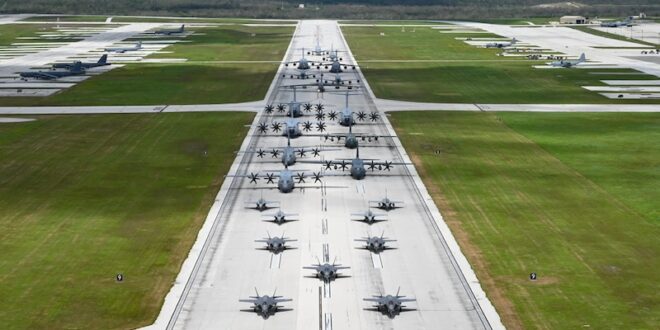In the 2010s, the global landscape changed. The Arab Spring, the Russian occupation of Crimea, and China’s national security law in Hong Kong were indicative of a profound change in the global system. The era of the unipolar moment, when the United States was the world’s sole dominant power, has ended. This is not to say that America’s decline is inevitable, but rather that the balance of power in the world is changing gradually, and Washington is no longer dictating the full course of geopolitical events around the globe.
In the 2020s, and against the backdrop of the Russian invasion of Ukraine, increasing tensions around Taiwan, and the growing strategic partnership between China and Russia, the United States and its foreign policy intelligentsia are pursuing a multifront containment strategy. Furthermore, the success of helping Ukraine not fall into Russia’s hands boosted America’s confidence after a hasty withdrawal from Afghanistan that had put it into question by allies and partners from Europe to the Middle East and Asia.
However, the early success in Ukraine tempts Washington to seek global primacy and the unrealistic conquest to defy the new emerging multipolar order rather than a sober foreign policy that is actively grappling with crafting a new role for the United States in the twenty-first century that balances between the nation’s strategic resource scarcity and more defined national interests that is tied to the welfare of the American people, or as the Biden intellectuals call it, a “foreign policy for the middle class.”
The Ukraine Temptation
Before the Russian invasion of Ukraine, the Biden administration prioritized and directed its resources toward the Chinese threat in the Indo-Pacific by revitalizing the Quad, inking AUKUS, and stepping up its strategic alliances and partnerships with Australia, Japan, and South Korea—moves that reflect Biden’s “Asia-first” strategy. With Putin’s tanks rolling into Ukraine, the United States changed course, arming Ukraine, which is not a formal US ally, providing Kyiv with intelligence and economic assistance, and imposing draconian sanctions on Russia that crippled Moscow’s economy.
After a hasty withdrawal from Afghanistan, America’s success in Ukraine not only regained the lost confidence in its capabilities and competence but also ushered in a new conquest to save Washington’s self-defined rules-based liberal international order, or in other words, global primacy. US diplomats went on a mission to convince partners and allies in Africa, the Middle East, Asia, and Latin America to align with the United States on its position on the Russian invasion of Ukraine. Ukraine became front and center to US diplomatic and political engagement with everyone, everywhere.
The Ukraine temptation manifested itself in the United States urging its allies and partners to align with Washington’s strategy for a broad alignment against Russia and China simultaneously. Washington now treats Europe and the Indo-Pacific as one linked strategic theater. The United States expects all of its allies and partners to maintain the same approach towards China and Russia, regardless of their strategic position or relationship to the Indo-Pacific and Europe. In his recent visits to Japan and Australia, President Joe Biden “huddles with allies on their continued response to Russia’s invasion of Ukraine as well as ways to confront China’s assertive economic and military moves in the Indo-Pacific region.”
The Folly of Merging the Indo-Pacific and Europe
Washington succeeded in its conquest, and currently, the United Kingdom, Japan, Australia, and individual European countries are gradually aligning themselves with the US-led alliance to dually contain the Russia-China axis. The strategic manifestation of this approach is the geopolitical merging of the Indo-Pacific and Europe. The aim is to consolidate political, military, economic, and technological capabilities, deterring China and Russia from undermining the liberal international order and tipping the geopolitical balance of power against the West.
However, this inter-theater approach faces challenges from consequential states like Turkey, Saudi Arabia, Indonesia, India, and other middle and regional powers. These nations prioritize strategic autonomy and resist external constraints in foreign policy decision-making. They would actively collaborate in formats such as the G20 to undermine the emerging collective Western posture of treating Europe and the Indo-Pacific as a single geopolitical theater. Furthermore, merging the European theater with the Indo-Pacific could be a strategic blunder. It would necessitate diverting resources from allies that could be better utilized in their respective theaters. European allies should focus on Ukraine and Eastern Europe, while Asian allies should concentrate on Taiwan and the Indo-Pacific region.
Conclusion
Despite the optimistic aspirations in Washington that the collective West could carry the burden of dual containment against China and Russia, it will ultimately fall on Washington alone to pursue this resource-consuming strategy to maintain global primacy. The Russian invasion of Ukraine sent a clear message that the United States could no longer prevent revisionist powers from challenging the global order that Washington had established and committed to uphold after World War II.
With America’s position as the center of the global order, it is currently navigating a significant transformation marked by a gradual shift of global power towards the East and Asia more broadly. In response to these evolving dynamics, the United States must exhibit adaptability and embrace the necessity of adjusting rather than stubbornly resisting these geopolitical changes. As a nation, it is crucial for the United States to acknowledge the inherent limitations, cost, and unsustainability of pursuing global primacy or an expansive definition of American interests and responsibilities. Washington can’t do everything everywhere, all at once.
 Eurasia Press & News
Eurasia Press & News


